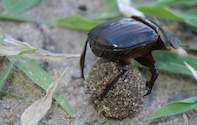
Chafer Beetles and Wasps
All beetles belong to the order Coleoptera - which is 'the largest and most diverse order in the entire animal kingdom'. Of at least 370,000 identified species, 18,000 are known from the southern African region. From the family - Scarabaeidae - (which includes dung beetles and chafers) - a few of the more colourful flower and fruit chafers are shown for comparison.

All wasps, bees, ants and associated insects belong to the order Hymenoptera - with '198,000 identified species' - of which around 6,000 species are known from this region. Wasps belong to the suborder Apocrita with many varied and interesting families.

Here, we will focus only on some of the paper wasps - of the family Vespidae - that chew plant material to form the 'paper' from which they construct their delicate comb-nests. Several species can be identified by 'telescopic' segments in their second abdomen. When the segments are extended during defensive posture a yellow or orange warning band becomes visible.
Interactions
Scarabs and dung beetles generally feed on fresh or decaying plant matter and lay their eggs in rotting plant litter or animal manure. The well-known fat, white, 'C' shaped larvae develop in compost and manure. Paper wasps feed mainly on nectar and larvae in the form of caterpillars. Many adult wasps feed their own larvae on these chewed caterpillars.

The wasp larvae develop within the cells of the 'paper' comb and these larvae become the food targets of the predatory hive chafer - Hoplostomus fuligineus - which looks similar to some other black chafers. When threatened, paper wasps vigorously defend their nests with painful stings.

Unlike honey bees, which die after losing their sting during an attack, wasps retain their sting for repeated use.
This defence is, however, ineffective against certain thick-shelled invaders, such as the hive chafer, which often devours the complete brood of wasp larvae and destroys the nest.

I have noticed these predatory beetles to be particularly active this year in the destruction of wasps. Apart from their disruptive and painful defence against humans, wasps are generally very beneficial to agriculture, whereas the beetles can be a pest. The paper wasps may have no defence against their beetle predators but some of their wasp relatives are able to control the raiders.

'The principal parasitoid families in the Superfamily Vespoidea (and I quote from the Encyclopedia of Insects by Christopher O'Toole) are the Scoliidae, Tiphiidae and Mutillidae. All scoliids and most tiphiids develop as external parasitoids of subterranean larvae of chafer beetles (family Scarabaeidae).

The tiphiid genus Methocha parasitises the larvae of tiger beetles (Cicindela species) in their burrows; females are wingless and resemble ants. Wingless females are characteristic of an entire tiphiid subfamily, the Thynninae - most thynnines are assumed to attack scarabaeid larvae'.

So - although the hive chafers wipe out many paper wasp nests, the parasitoid wasp-relatives destroy a similar number of chafer beetle larvae - thus helping to maintain an important ecological balance.

This is just one of the vital, but un-noticed, interactions going on around us that can so easily be destroyed by uninformed, chemical control methods. Think - and weigh up the possible effects before you carelessly use chemicals - including drugs and alcohol. Clear thinking is as important as environmental stability for this country and our own survival.
Read more fascinating environmental and wildlife articles by Dave Rushworth

